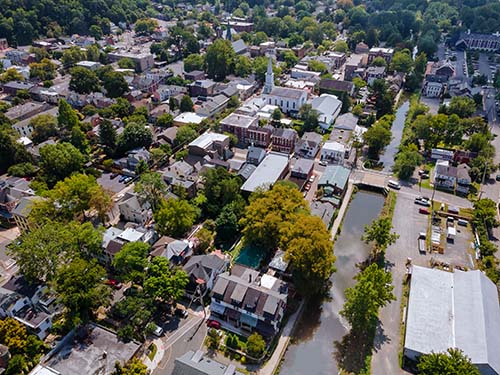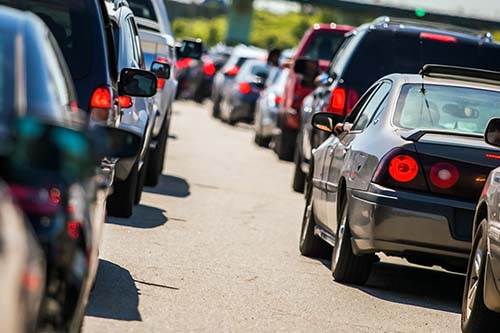November 21 | 2017
9am – 10am pacific | 12 noon – 1pm eastern
VIDEO AVAILABLE
 Main drivers of air pollution, greenhouse gas emissions, and urban environmental inequities often overlap, yet rarely do our efforts to address these problems are carried out in an integrated manner.
Main drivers of air pollution, greenhouse gas emissions, and urban environmental inequities often overlap, yet rarely do our efforts to address these problems are carried out in an integrated manner.
The growing political will to reduce greenhouse gas emissions around the world is likely to bring significant investments into mitigation policies, including in urban areas. In this policy context, without rigorous coordination between policies that target climate, air pollution, and environmental justice, cities can miss on a unique opportunity to harvest ancillary public health and societal benefits from their climate investments.
In this talk we explore methods that rely on air quality models and mathematical analyses to quantify the impact of individual pollution sources on various policy endpoints such as health or environmental justice.
We provide examples of decision metrics that link various endpoints to sources of air pollution, and explore ways to leverage the wide range of expertise within CANUE to incorporate such quantitative analyses into an integrated assessment platform.
 Amir Hakami is an Associate Professor in the Department of Civil and Environmental Engineering at Carleton University. His expertise is in air quality modeling and use of mathematical methods within these models to address problems that lie at the interface of policy, health, and economics of air pollution.
Amir Hakami is an Associate Professor in the Department of Civil and Environmental Engineering at Carleton University. His expertise is in air quality modeling and use of mathematical methods within these models to address problems that lie at the interface of policy, health, and economics of air pollution.
 Robyn Chatwin-Davies is a Master’s student at Carleton University studying atmospheric modelling and air quality. Specifically, her research focuses on environmental justice, as she seeks to understand the relationship between pollution and socio-economic status. Robyn previously completed a Bachelor in Environmental Engineering, graduating with High Distinction in 2012.
Robyn Chatwin-Davies is a Master’s student at Carleton University studying atmospheric modelling and air quality. Specifically, her research focuses on environmental justice, as she seeks to understand the relationship between pollution and socio-economic status. Robyn previously completed a Bachelor in Environmental Engineering, graduating with High Distinction in 2012.
 Angele Genereux is currently completing her Master’s degree in Environmental Engineering at Carleton, after completing a Bachelor of Engineering degree at the same department in 2016. Her work focuses on estimating the health damage from vehicular emissions on an age-segregated basis, and on ways that these emissions affect environmental health in densely populated urban areas.
Angele Genereux is currently completing her Master’s degree in Environmental Engineering at Carleton, after completing a Bachelor of Engineering degree at the same department in 2016. Her work focuses on estimating the health damage from vehicular emissions on an age-segregated basis, and on ways that these emissions affect environmental health in densely populated urban areas.
 Audrey Smargiassi is an Associate Professor at the Department of Environmental and Occupational Health at the School of Public Health and a researcher at the Public Health Research Institute at the University of Montreal.
Audrey Smargiassi is an Associate Professor at the Department of Environmental and Occupational Health at the School of Public Health and a researcher at the Public Health Research Institute at the University of Montreal. Larisa Ines Yankoty is a PhD Candidate in Public Health, Epidemiology at the School of Public Health at the University of Montreal.
Larisa Ines Yankoty is a PhD Candidate in Public Health, Epidemiology at the School of Public Health at the University of Montreal.


 Main drivers of air pollution, greenhouse gas emissions, and urban environmental inequities often overlap, yet rarely do our efforts to address these problems are carried out in an integrated manner.
Main drivers of air pollution, greenhouse gas emissions, and urban environmental inequities often overlap, yet rarely do our efforts to address these problems are carried out in an integrated manner. Amir Hakami is an Associate Professor in the Department of Civil and Environmental Engineering at Carleton University. His expertise is in air quality modeling and use of mathematical methods within these models to address problems that lie at the interface of policy, health, and economics of air pollution.
Amir Hakami is an Associate Professor in the Department of Civil and Environmental Engineering at Carleton University. His expertise is in air quality modeling and use of mathematical methods within these models to address problems that lie at the interface of policy, health, and economics of air pollution. Robyn Chatwin-Davies is a Master’s student at Carleton University studying atmospheric modelling and air quality. Specifically, her research focuses on environmental justice, as she seeks to understand the relationship between pollution and socio-economic status. Robyn previously completed a Bachelor in Environmental Engineering, graduating with High Distinction in 2012.
Robyn Chatwin-Davies is a Master’s student at Carleton University studying atmospheric modelling and air quality. Specifically, her research focuses on environmental justice, as she seeks to understand the relationship between pollution and socio-economic status. Robyn previously completed a Bachelor in Environmental Engineering, graduating with High Distinction in 2012. Angele Genereux is currently completing her Master’s degree in Environmental Engineering at Carleton, after completing a Bachelor of Engineering degree at the same department in 2016. Her work focuses on estimating the health damage from vehicular emissions on an age-segregated basis, and on ways that these emissions affect environmental health in densely populated urban areas.
Angele Genereux is currently completing her Master’s degree in Environmental Engineering at Carleton, after completing a Bachelor of Engineering degree at the same department in 2016. Her work focuses on estimating the health damage from vehicular emissions on an age-segregated basis, and on ways that these emissions affect environmental health in densely populated urban areas.